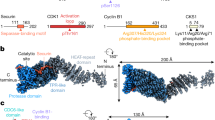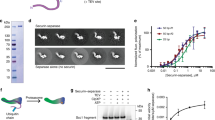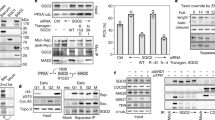Abstract
Separase is a cysteine protease with a crucial role in the dissolution of cohesion among sister chromatids during chromosome segregation1,2,3,4,5,6,7. In human tumours separase is overexpressed, making it a potential target for drug discovery8. The protease activity of separase is strictly regulated by the inhibitor securin, which forms a tight complex with separase and may also stabilize this enzyme9,10,11,12,13,14,15,16. Separases are large, 140–250-kilodalton enzymes, with an amino-terminal α-helical region and a carboxy-terminal caspase-like catalytic domain. Although crystal structures of the C-terminal two domains of separase17 and low-resolution electron microscopy reconstructions of the separase–securin complex18,19 have been reported, the atomic structures of full-length separase and especially the complex with securin are unknown. Here we report crystal structures at up to 2.6 Å resolution of the yeast Saccharomyces cerevisiae separase–securin complex. The α-helical region of separase (also known as Esp1) contains four domains (I–IV), and a substrate-binding domain immediately precedes the catalytic domain and has tight associations with it. The separase–securin complex assumes a highly elongated structure. Residues 258–373 of securin (Pds1), named the separase interaction segment, are primarily in an extended conformation and traverse the entire length of separase, interacting with all of its domains. Most importantly, residues 258–269 of securin are located in the separase active site, illuminating the mechanism of inhibition. Biochemical studies confirm the structural observations and indicate that contacts outside the separase active site are crucial for stabilizing the complex, thereby defining an important function for the helical region of separase.
This is a preview of subscription content, access via your institution
Access options
Access Nature and 54 other Nature Portfolio journals
Get Nature+, our best-value online-access subscription
$29.99 / 30 days
cancel any time
Subscribe to this journal
Receive 51 print issues and online access
$199.00 per year
only $3.90 per issue
Buy this article
- Purchase on Springer Link
- Instant access to full article PDF
Prices may be subject to local taxes which are calculated during checkout




Similar content being viewed by others
References
Uhlmann, F., Wernic, D., Poupart, M. A., Koonin, E. V. & Nasmyth, K. Cleavage of cohesin by the CD clan protease separin triggers anaphase in yeast. Cell 103, 375–386 (2000)
Hauf, S., Waizenegger, I. C. & Peters, J.-M. Cohesin cleavage by separase required for anaphase and cytokinesis in human cells. Science 293, 1320–1323 (2001)
Nasmyth, K. Segregating sister genomes: the molecular biology of chromosome separation. Science 297, 559–565 (2002)
Peters, J.-M. The anaphase-promoting complex: proteolysis in mitosis and beyond. Mol. Cell 9, 931–943 (2002)
Uhlmann, F. Separase regulation during mitosis. Biochem. Soc. Trans. 70, 243–251 (2003)
Yanagida, M. Cell cycle mechanisms of sister chromatid separation; roles of Cut1/separin and Cut2/securin. Genes Cells 5, 1–8 (2000)
Sullivan, M., Hornig, N. C. D., Porstmann, T. & Uhlmann, F. Studies on substrate recognition by the budding yeast separase. J. Biol. Chem. 279, 1191–1196 (2004)
Zhang, N. et al. Identification and characterization of separase inhibitors (Sepins) for cancer therapy. J. Biomol. Screen. 19, 878–889 (2014)
Ciosk, R. et al. An ESP1/PDS1 complex regulates loss of sister chromatid cohesion at the metaphase to anaphase transition in yeast. Cell 93, 1067–1076 (1998)
Zou, H., McGarry, T. J., Bernal, T. & Kirschner, M. W. Identification of a vertebrate sister-chromatid separation inhibitor involved in transformation and tumorigenesis. Science 285, 418–422 (1999)
Waizenegger, I., Giménez-Abián, J. F., Wernic, D. & Peters, J.-M. Regulation of human separase by securin binding and autocleavage. Curr. Biol. 12, 1368–1378 (2002)
Hornig, N. C. D., Knowles, P. P., McDonald, N. Q. & Uhlmann, F. The dual mechanism of separase regulation by securin. Curr. Biol. 12, 973–982 (2002)
Jallepalli, P. V. et al. Securin is required for chromosomal stability in human cells. Cell 105, 445–457 (2001)
Nagao, K. & Yanagida, M. Securin can have a separase cleavage site by substitution mutations in the domain required for stabilization and inhibition of separase. Genes Cells 11, 247–260 (2006)
Wirth, K. G. et al. Separase: a universal trigger for sister chromatid disjunction but not chromosome cycle progression. J. Cell Biol. 172, 847–860 (2006)
Csizmok, V., Felli, I. C., Tompa, P., Banci, L. & Bertini, I. Structural and dynamic characterization of intrinsically disordered human securin by NMR spectroscopy. J. Am. Chem. Soc. 130, 16873–16879 (2008)
Lin, Z., Luo, X. & Yu, H. Structural basis of cohesin cleavage by separase. Nature 532, 131–134 (2016)
Viadiu, H., Stemmann, O., Kirschner, M. W. & Walz, T. Domain structure of separase and its binding to securin as determined by EM. Nat. Struct. Mol. Biol. 12, 552–553 (2005)
Bachmann, G. et al. A closed conformation of the Caenorhabditis elegans separase-securin complex. Open Biol. 6, 160032 (2016)
Pfleger, C. M. & Kirschner, M. W. The KEN box: an APC recognition signal distinct from the D box targeted by Cdh1. Genes Dev. 14, 655–665 (2000)
Sun, Y. et al. Separase is recruited to mitotic chromosomes to dissolve sister chromatid cohesion in a DNA-dependent manner. Cell 137, 123–132 (2009)
Holm, L., Kääriäinen, S., Rosenström, P. & Schenkel, A. Searching protein structure databases with DaliLite v.3. Bioinformatics 24, 2780–2781 (2008)
Takayanagi, H., Yuzawa, S. & Sumimoto, H. Structural basis for the recognition of the scaffold protein Frmpd4/Preso1 by the TPR domain of the adaptor protein LGN. Acta Crystallogr. F. 71, 175–183 (2015)
Carminati, M. et al. Concomitant binding of Afadin to LGN and F-actin directs planar spindle orientation. Nat. Struct. Mol. Biol. 23, 155–163 (2016)
Pan, Z. et al. Structural and biochemical characterization of the interaction between LGN and Frmpd1. J. Mol. Biol. 425, 1039–1049 (2013)
Winter, A., Schmid, R. & Bayliss, R. Structural insights into separase architecture and substrate recognition through computational modelling of caspase-like and death domains. PLoS Comput. Biol. 11, e1004548 (2015)
Song, J. J., Smith, S. K., Hannon, G. J. & Joshua-Tor, L. Crystal structure of Argonaute and its implications for RISC slicer activity. Science 305, 1434–1437 (2004)
Rao, H., Uhlmann, F., Nasmyth, K. & Varshavsky, A. Degradation of a cohesin subunit by the N-end rule pathway is essential for chromosome stability. Nature 410, 955–959 (2001)
Holt, L. J. et al. Global analysis of Cdk1 substrate phosphorylation sites provides insights into evolution. Science 325, 1682–1686 (2009)
Agarwal, R. & Cohen-Fix, O. Phosphorylation of the mitotic regulator Pds1/securin by Cdc28 is required for efficient nuclear localization of Esp1/separase. Genes Dev. 16, 1371–1382 (2002)
Fitzgerald, D. J. et al. Protein complex expression by using multigene baculoviral vectors. Nat. Methods 3, 1021–1032 (2006)
Otwinowski, Z. & Minor, W. Processing of X-ray diffraction data collected in oscillation mode. Methods Enzymol. 276, 307–326 (1997)
Vonrhein, C., Blanc, E., Roversi, P. & Bricogne, G. Automated structure solution with autoSHARP. Methods Mol. Biol. 364, 215–230 (2007)
Emsley, P. & Cowtan, K. Coot: model-building tools for molecular graphics. Acta Crystallogr. D 60, 2126–2132 (2004)
Adams, P. D. et al. PHENIX: building new software for automated crystallographic structure determination. Acta Crystallogr. D 58, 1948–1954 (2002)
Gouet, P., Courcelle, E., Stuart, D. I. & Métoz, F. ESPript: analysis of multiple sequence alignments in PostScript. Bioinformatics 15, 305–308 (1999)
Zhang, S. et al. Molecular mechanism of APC/C activation by mitotic phosphorylation. Nature 533, 260–264 (2016)
Wang, Y. et al. Nucleation, propagation and cleavage of target RNAs in Ago silencing complexes. Nature 461, 754–761 (2009)
Johnson, S. J. et al. Crystal structure and RNA binding of the Tex protein from Pseudomonas aeruginosa. J. Mol. Biol. 377, 1460–1473 (2008)
Acknowledgements
We thank H. Zhang, S. Xiang and L. Cunha for carrying out initial studies on this project; S. Banerjee, K. Perry, R. Rajashankar, J. Schuermann, N. Sukumar for access to NE-CAT 24-C and 24-E beamlines at the Advanced Photon Source. This research is supported by grants R35GM118093 and S10OD012018 from the NIH to L.T. This work is based upon research conducted at the Northeastern Collaborative Access Team beamlines, funded by the NIH (P41 GM103403). The Pilatus 6M detector on 24-ID-C beam line is funded by an NIH-ORIP HEI grant (S10 RR029205). This research used resources of the Advanced Photon Source, a US Department of Energy (DOE) Office of Science User Facility operated by Argonne National Laboratory under Contract no. DE-AC02-06CH11357.
Author information
Authors and Affiliations
Contributions
S.L. carried out cloning, protein expression, purification, crystallization, data collection, structure determination and refinement, and site-directed mutagenesis. L.T. initiated the project, supervised the research, and analysed the results. S.L. and L.T. wrote the paper.
Corresponding author
Ethics declarations
Competing interests
The authors declare no competing financial interests.
Additional information
Reviewer Information Nature thanks K. Nasmyth, O. Stemmann, F. Uhlmann and the other anonymous reviewer(s) for their contribution to the peer review of this work.
Extended data figures and tables
Extended Data Figure 1 Sequence alignment of domains I and II of separase.
The secondary structure elements in the S. cerevisiae separase structure are shown and labelled. The boundaries of the domains are indicated. Residues in contact with securin are indicated by the purple dots. Ag, Ashbya gossypii; Kl, Kluyveromyces lactis; Sc, Saccharomyces cerevisiae; Zr, Zygosaccharomyces rouxii. Modified from an output from ESPript36.
Extended Data Figure 2 Sequence alignment of domains III and IV of separase.
The secondary structure elements in the S. cerevisiae separase structure are shown.
Extended Data Figure 3 Sequence alignment of the SD and CD of separase.
The catalytic Cys1531 and His1505 residues are indicated by the red dots. Ct, Chaetomium thermophilum; Hs, Homo sapiens; Sp, Schizosaccharomyces pombe.
Extended Data Figure 4 Sequence alignment of securin.
The SIS is indicated. Residues in contact with separase are indicated by the blue dots. Residue 263 is equivalent to the P1 residue of separase substrates, and is indicated by the red asterisk. Residues 317–360 of S. cerevisiae securin are disordered in the current structures and are poorly conserved in sequence.
Extended Data Figure 5 Overlay of the structures of the separase–securin complexes.
a, The complex formed by residues 71–1630 of separase and 258–373 of securin is shown in colour, and that by residues 51–1630 of separase and 258–373 of securin in grey. Residues 73–80 from another molecule of separase in the crystal is shown in orange, forming a β-sheet with the N-terminal segment of separase. b, Panel a viewed after a 50° rotation around the vertical axis.
Extended Data Figure 6 Additional structural information on the separase–securin complex.
a, 2Fo − Fc electron density for helices 4 and 5 of domain I at 2.6 Å resolution, contoured at 1σ. Helices 6 and 7 are also shown for reference. The directions of the helices are indicated by the red arrows. b, The β4A–β4B segment of CD (cyan) is immediately after the catalytic Cys1531 residue, and has interactions with domain III (light blue). The equivalent segment in the C. thermophilum SD–CD-free enzyme structure is a loop (L4), shown in dark grey. c, Interactions between residues 290–296 of securin SIS (magenta) with domains III (light blue) and II (light brown) of separase. d, Interactions between the C-terminal segment of securin SIS (magenta) and domain I of separase (green). Deletion of the first 155 residues of separase12 would remove helix α3 in this binding site.
Extended Data Figure 7 Structural homologues of domains III and SD of separase.
a, Overlay of the structures of domain III of separase (colour from N (blue) to C (red) terminus) and the TPR domain of LGN (grey, PDB accession 4WNG; 11% sequence identity, Z-score of 14.4)23,24,25. The Frmpd4 ligand (black) of LGN is bound to a different region of the structure compared to securin. b, Overlay of the structures of domain III of separase and the subunit 7 of the APC/C (PDB accession 5G04; 5% identity, 14.3 Z-score)37. c, Overlay of the structures of the SD of separase (green) and a part of the PIWI domain of Argonaute (grey, PDB accession 4N76; 10% sequence identity, 5.5 Z-score). As a comparison, matching this β-sheet to that in C. thermophilum separase produced a Z score of 5.7 (refs 27, 38). Residues in the helical insert between β3 and β4 of separase are removed for clarity. d, Overlay of the structures of the SD of separase and the YqgF domain of Tex (grey, PDB accession 3BZK; 4% sequence identity, 5.5 Z-score)39.
Extended Data Figure 8 Possible binding groove for the P′ residues of the substrate.
a, Alignment of the separase cleavage sites in Scc1 substrates. The two cleavage sites in each protein are named ‘a’ and ‘b’. The equivalent residues in securin are also shown. Asterisks indicate securin mutants (mutations in green) that become substrates of separase. The P and P′ residues are labelled at the top, and the cleavage site is indicated by the vertical line. b, The overall binding mode of residues 258–271 of securin in separase. The β4A–β4B segment of CD (cyan) is a loop (L4, dark grey) in the C. thermophilum SD–CD structure. c, A groove in the active site of separase (red arrows) can accommodate the P′ residues. The blue arrow indicates another groove in this region, but the binding mode of securin suggests that the groove indicated by the red arrows is more likely.
Extended Data Figure 9 Biochemical characterizations of the interactions between separase and securin.
Zygosaccharomyces rouxii separase was co-expressed with various segments of Z. rouxii securin, with truncations at the N and/or C terminus. The insoluble fraction was run on SDS–PAGE. The position of separase (with an N-terminal His tag) is indicated with the black arrowhead. WT, full-length Z. rouxii separase; WT-CS, full-length Z. rouxii separase with C1497S mutation; WT′, Z. rouxii separase with an internal deletion of residues 952–1010, corresponding to a segment in domain IV of the S. cerevisiae separase structure. For gel source data, see Supplementary Fig. 1.
Supplementary information
Supplementary Figures
This file contains the source gel images for Figure 4b and Extended Data Figure 11. (PDF 852 kb)
Rights and permissions
About this article
Cite this article
Luo, S., Tong, L. Molecular mechanism for the regulation of yeast separase by securin. Nature 542, 255–259 (2017). https://doi.org/10.1038/nature21061
Received:
Accepted:
Published:
Issue Date:
DOI: https://doi.org/10.1038/nature21061
This article is cited by
-
Two giants of cell division in an oppressive embrace
Nature (2021)
-
A prometaphase mechanism of securin destruction is essential for meiotic progression in mouse oocytes
Nature Communications (2021)
-
Structural basis of human separase regulation by securin and CDK1–cyclin B1
Nature (2021)
-
Cohesin cleavage by separase is enhanced by a substrate motif distinct from the cleavage site
Nature Communications (2019)
-
Conservation of the separase regulatory domain
Biology Direct (2018)
Comments
By submitting a comment you agree to abide by our Terms and Community Guidelines. If you find something abusive or that does not comply with our terms or guidelines please flag it as inappropriate.



